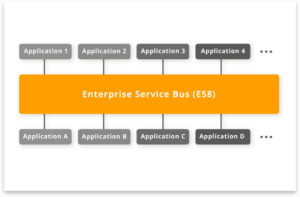One of the most important partnerships in business is the relationship between your eCommerce website and your ERP. Like a loving couple, the two must come together in digital matrimony to create a bond that stands the test of time. Matchmakers call this a wedding; businesspeople call it eCommerce ERP integration.
If you are entering eCommerce for the first time or are already operating a stand-alone website, here is what you need to know about eCommerce and ERP integration.
Why eCommerce ERP Integration Matters
What makes the ERP and eCommerce relationship so special? Well, taken individually they only give you a portion of the data you need to determine your financial situation and the sales and marketing information necessary to grow. Your ERP alone cannot provide the digital shopping experience your customers want. But, your eCommerce platform alone can’t tell you if a sale is profitable or from what warehouse an item may ship. But bring the two together and you’ve got a perfect marriage of data.
Improved Customer Experience
eCommerce and ERP integration provide your customers a better experience. For example, when the ERP tells the eCommerce platform the number of items in inventory, the website tells shoppers if an item is in stock. This transparency into the supply chain is almost mandatory for modern eCommerce websites.
Reduced Costs and Errors
When data flows from the eCommerce platform to the ERP automatically, it reduces human intervention. Fewer humans equal lower cost and fewer frequent errors. Let’s face it, people are expensive and prone to error. With these system integrations, an order is only input once – generally by the customer. After the eCommerce platform captures the order details, there’s no need to manually enter them into the ERP. This saves data entry time and reduces data entry errors. If there’s an order entry error, it’s made by the customer. Integration automates the workflow and reduces errors. This saves money.
Improved Control
Once you integrate your ERP and eCommerce platform you’ll be the blissful one. Sales data flows into the ERP for better financial accounting. This means a more accurate income statement and P/L reports. By breaking down data silos, managers and teams obtain access to the information they need to accomplish their goals. You’ll see improvements on project status insights and even be able to allocate labor to sales for custom orders with one dashboard.
Challenges to Integration
We’ve all heard of love at first sight. Two people meet, fall in love, and marry immediately. With eCommerce ERP integration, the wedding isn’t so easy. There are integration challenges to overcome.
ERPs are Highly Customized
Every business is different. There are different ways of costing goods, different ways for determining sales prices, and even different ways of valuing your inventory (LIFO versus FIFO anyone?). Even the most standard, basic ERP solutions are highly customizable by installation. And the longer the ERP has been in use, the more custom it is likely to be. These unique customizations make it almost impossible for out-of-the-box integrations. Your ERP is unlikely to operate as a plug-and-play partner with any other business solution because of these customizations.
ERPs area Rarely Updated
Because the ERP is highly customizable, it is exceedingly difficult and costly to update. Solutions that are costly to update often just don’t get an update. It’s a common business practice. The oldest legacy solution in almost any company is the ERP.
So, when eCommerce platforms declare they can integrate with an ERP, they mean the latest edition of the ERP. That’s probably not the version you are running since your ERP hasn’t been updated since 2012 (if then).
Technical Challenges
Yes, there is strength in diversity. But when it comes to data, diversity is a problem. The ERP and eCommerce platforms rarely agree with the format for data, and that makes integration difficult. Product hierarchies and description field length may be different. Then there’s the problem of differing customer data fields.
Integration Strategies
Just because eCommerce ERP integration is difficult doesn’t mean you should avoid it. On the contrary, the benefits outweigh the challenges. Here are the three most common integration strategies.
Point to Point
With a point-to-point integration strategy, the ERP and eCommerce platforms are directly integrated. This is a perfect solution if you only use ERP, eCommerce, and maybe one or two other solutions at the most. That’s because point-to-point integration gets complex quickly when there are more than two or three solutions. So, if you intend to grow, avoid this approach and look for a more scalable approach, like middleware.
Middleware Strategy 1 – The Hub Approach
Middleware puts a layer between the ERP and the eCommerce platform. It allows you to integrate more solutions much easier. The architecture looks like a wire-spoked wheel. In the center, you have a hub with applications that all connect by a spoke.
The spoke goes between the application and Hub to translate application data into a format the Hub understands. The Hub handles messages and transforms an incoming message into a format the destination application can understand and then sends messages along.
The strategy works great if you have the hardware to handle scaling in the future.
Middleware Strategy 2 – Enterprise Service Bus
The second way to utilize middleware is to establish an enterprise service bus – then all applications can just jump on the bus for a chat.
The bus is a messaging conduit, but it doesn’t perform middleware tasks associated with a Hub (like transforming the data and then routing). The message transformation and routing happen in the application connectors. This strategy is certainly more scalable. When you need to integrate an application, you just build a connector.
Synchronization Strategies
Once you’ve determined the integration method, it’s time to decide how often the data will transfer. Or in other words, once eCommerce and ERP are married, how often will they talk?
Batch
With batch processing the ERP and eCommerce save up everything they need to say and share it over breakfast in the morning or over a drink before bedtime. Well, not exactly. But batch processing shares data at regular intervals. This could be every few hours, once a day, or just a few times a week. It all depends on the volume of data to exchange.
In this example, the eCommerce platform may hold all orders until 10:00 am when it sends them over to the ERP for fulfillment. Then at 5:00 pm, the ERP may send over tracking information and paid invoices. The eCommerce platform might thank the ERP with orders that arrive after 10:00 am to begin processing them in the morning. You get the idea. Data is exchanging at regular intervals depending on the business needs.
Real-Time
In a fast-moving and dynamic environment, data can’t wait to transfer. This is where we use real-time processing. The eCommerce and ERP constantly scan, looking for changes in data, and these changes are immediately transmitted. If you’ve ever made a withdrawal from an ATM, you’ll notice your balance is affected by the withdrawal. That’s real-time synchronization.
Selecting eCommerce to Integrate with ERP
When selecting your eCommerce platform, you’ll want to keep an eye on the integration possibilities. Your two choices for eCommerce will boil down to open source and proprietary platforms.
Keep in mind that proprietary solutions are more difficult to integrate because the source code is hidden. If you use proprietary eCommerce, verify that it will integrate with your customizable (and probably older) ERP.
Open source solutions are easier to integrate. The code is available for view and editing and you will possibly find a more robust API.
Source: https://www.mikegingerich.com/blog/ecommerce-erp-integration-101/
- https://www.mikegingerich.com/
- Mike Gingerich
- United States








